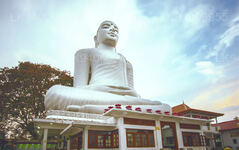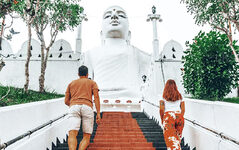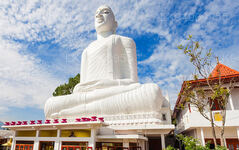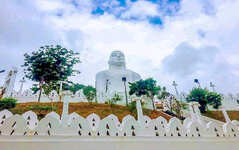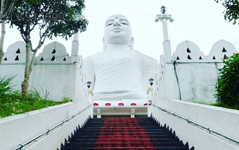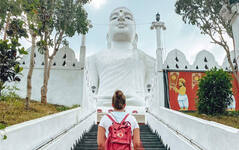
Cidade de Kandy
Kandy, uma cidade pitoresca no centro do Sri Lanka, é famosa por seu rico patrimônio cultural, festivais vibrantes e beleza cênica. Aninhada em meio a colinas verdejantes, abriga o Templo da Relíquia do Dente, Patrimônio Mundial da UNESCO, e oferece uma mistura cativante de história e esplendor natural.
Bahirawakanda Vihara Buddha Statue
Rising from a hill adjoining the holy city of Kandy is the giant Buddha statue of Bahirawa Kanda. The statue is a mere 2km from the Temple of The Tooth Relic and was built in 1972.
Folklore
Many legends surround the hill of Bahirawa Kanda which means ‘gnome mountain’; and about how this statue came to be. Chief amongst these are two stories.
The first speaks of an ancient temple to the primitive god of protection, Bahiravar; which was implanted there during the reign of the Nayakkar Kings. During the olden days in India, the standard methods of worship for this god often involved animal sacrifice; though human sacrifice was never involved. But for some reason this practice seems to have gotten twisted in the localisation process; and the priests of this temple threatened the wrath of the god unless hundreds of virgin women were sacrificed in time. The naive people of the region handed over a large number of girls for sacrifice and lived in fear of the god’s wrath. However, this came to an end when the fiance of the Chief of the Royal Mahouts was taken for sacrifice. The man, whose name was Dunuwilla Gajanayake Nilame, used his power in the palace and his bravery to get her released; and caused such a great disturbance that the sacrificing ritual was broken. This marked the end of the people’s fear and superstition; and the temple was abandoned with time.
Another story speaks of how the hill gained the name ‘Gnome Mountain’ or ‘Devil’s Hill’. According to this legend there was a time in the past when the mountain emitted strange noises and engulfed the people who lived nearby in abject fear. They believed that it was the work of an evil gnome and searched for a way to appease it. Meanwhile, unknown to anyone, an actual gnome had infilitrated the palace and taken the place of one of the ministers. Realising the opportunity; the ‘minister’ advised the king that the gnome would be appeased if a beautiful virgin was sacrificed every year, and hence a new superstition began. But then one year; the nominated sacrifice was the lover of the fake minister’s very own son. The villagers kidnapped her during the night, took her to the hill and left her there. The minister’s son discovered this in the morning and immediately set off to rescue her. He fought the gnome , his father, who had been there for his own nefarious purposes; and returned to the village. The alarmed and fearful people had begun to wonder if the rescue of the sacrifice had angered the gnome; when the cunning son quickly made a gnome sound (after all he was a gnome too, being the son of the original gnome). The people the took this to mean that the sacrifice was accepted; and the couple left the village that same night, instead of risk having their trick being discovered.
The Statue and the Sights
The Bahirawakanda Buddha Statue is located alongside the Sri Maha Bodhi Temple which is on the top of the Bahirawa Kanda hill. This beautifully sculpted white statue displays Buddha in the seated Nirvana pose and can be seen from the entire city of Kandy that sprawls out before it. It stands at 88 feet in height and is one of the biggest Buddha statues in Sri Lanka.
Visitors can climb the top of the hill for panoramic views of the City of Kandy, the inside of Bogambara Prison, and the mountain range nearby. It makes for some spectacular photographs and memories. The temple of Bahirawa Kanda is open for worship. Devotees are required to remove their hats and shoes; and can offer flowers or light oil lamps. There is also set of stairs that run behind the Buddha statue, that allow visitors to climb to a greater height for better views of the landscape. However, the best time to visit Bahirawakanda is at night, when the entire statue is lit up and the city of Kandy spreads out in a map of twinkling lights.
Sobre o distrito de Kandy
O distrito de Kandy está situado na província central do Sri Lanka. Um dos sete Patrimônios Mundiais do Sri Lanka, Kandy já foi o lar dos Reis Kandy de outrora no século XVI e uma fonte de toda a música, artes, artesanato e cultura do país. A cerca de 129 km de Colombo, Kandy está situada em um terreno montanhoso e todos os olhos são atraídos para o centro da cidade, onde o Lago Kandy forma uma característica encantadora. Kandy mantém grande significado religioso para o Sri Lanka, porque é nesta cidade encantadora que o Dalada Maligawa ou "Templo do Dente" está localizado, dentro do qual a relíquia sagrada do dente do Senhor Buda está bem guardada. O Jardim Botânico Real, Peradeniya, está situado a cerca de 5 km a oeste do centro da cidade em Peradeniya e é visitado por 1,2 milhão de pessoas por ano. É o maior jardim botânico da ilha. O Udawatta Kele (Floresta Udawatta) é um santuário protegido situado no coração da cidade, ao norte do Templo do Dente. Kandy é uma cidade de maioria cingalesa; há comunidades consideráveis pertencentes a outros grupos étnicos, como mouros e tâmeis. Kandy fica atrás apenas de Colombo no centro da economia do Sri Lanka. Muitas grandes cooperativas têm grandes filiais em Kandy e muitas indústrias, incluindo têxteis, móveis, tecnologia da informação e joias, são encontradas aqui. Muitos centros de pesquisa agrícola estão localizados na cidade. E uma fonte para toda a música, artes, artesanato e cultura do país. A cerca de 129 km de Colombo, Kandy está abrigada em um terreno montanhoso e todos os olhares são atraídos para o centro da cidade, onde o Lago Kandy forma uma característica encantadora. Kandy mantém grande significado religioso para o Sri Lanka, porque é nesta cidade encantadora que o Dalada Maligawa ou Templo do Dente está localizado, dentro do qual a relíquia sagrada do dente do Senhor Buda está bem guardada.
Sobre a Província Central
A Província Central do Sri Lanka é constituída principalmente por terrenos montanhosos. A província tem uma área de 5.674 km² e uma população de 2.421.148 habitantes. Algumas das principais cidades incluem Kandy, Gampola (24.730 habitantes), Nuwara Eliya e Bandarawela. A população é uma mistura de cingaleses, tâmeis e mouros. Tanto a capital montanhosa, Kandy, quanto a cidade de Nuwara Eliya estão localizadas na Província Central, assim como Sri Pada. A província produz grande parte do famoso chá do Ceilão, plantado pelos britânicos na década de 1860, após uma doença devastadora ter dizimado todas as plantações de café da província. A Província Central atrai muitos turistas, com cidades montanhosas como Kandy, Gampola, Hatton e Nuwara Eliya. O dente-de-templo ou Dalada maligawa é o principal local sagrado da província de Centrel. O clima é fresco e muitas áreas a cerca de 1.500 metros de altitude costumam ter noites frias. As encostas ocidentais são muito úmidas, com alguns locais recebendo quase 7.000 mm de chuva por ano. As encostas orientais fazem parte da zona meio seca, recebendo chuva apenas das monções do nordeste. As temperaturas variam de 24°C em Kandy a apenas 16°C em Nuwara Eliya, localizada a 1.889 m acima do nível do mar. As montanhas mais altas do Sri Lanka estão localizadas na Província Central. O terreno é predominantemente montanhoso, com vales profundos que o cortam. As duas principais regiões montanhosas são o Maciço Central e a Cordilheira Knuckles, a leste de Kandy.

